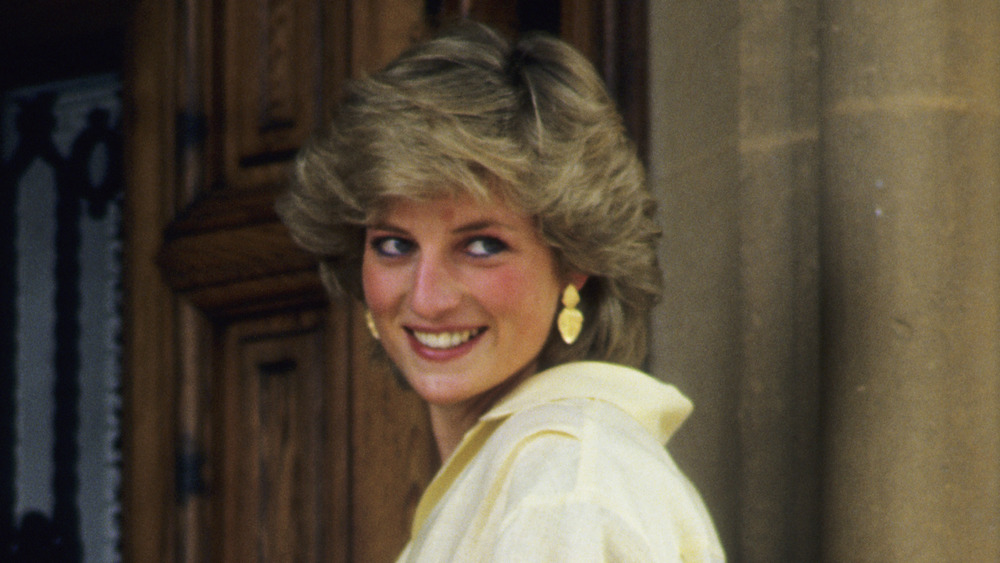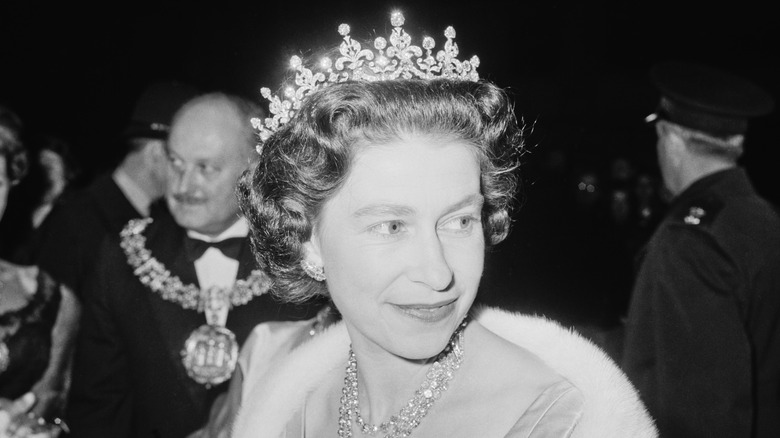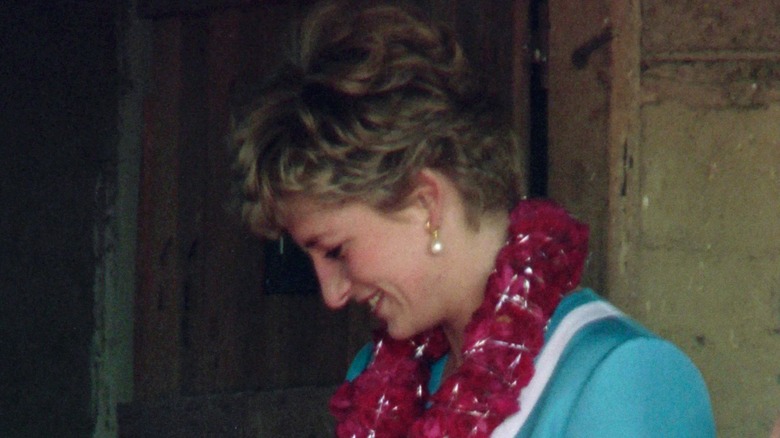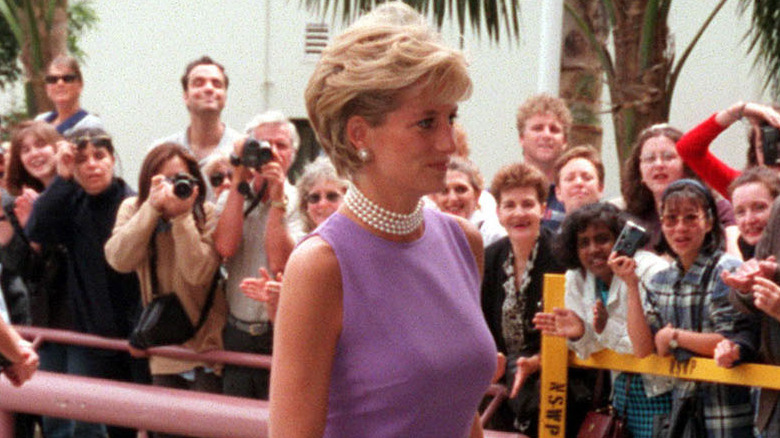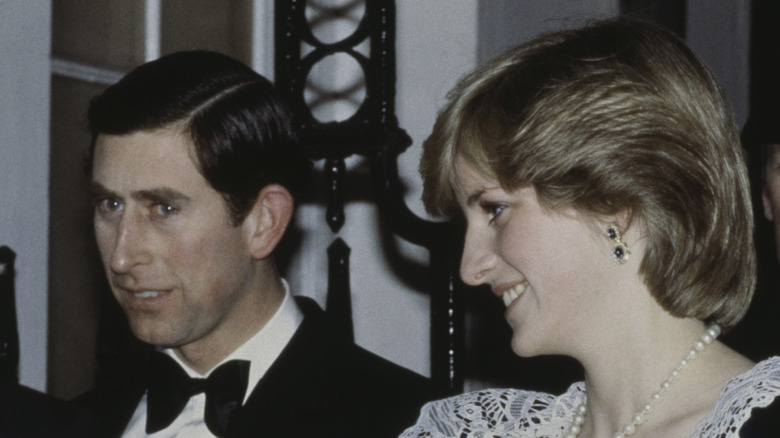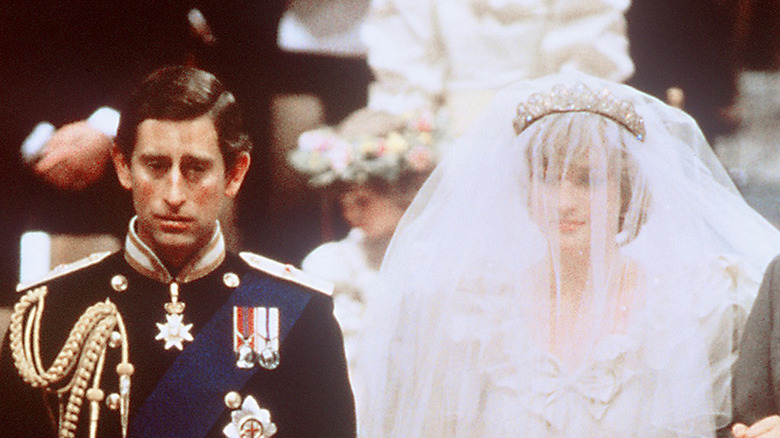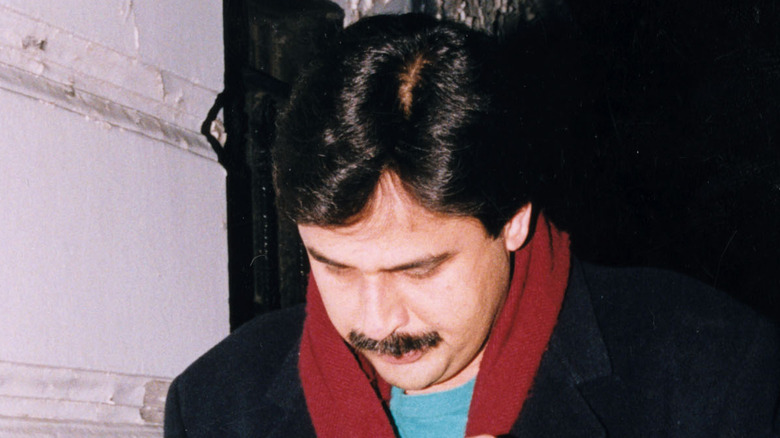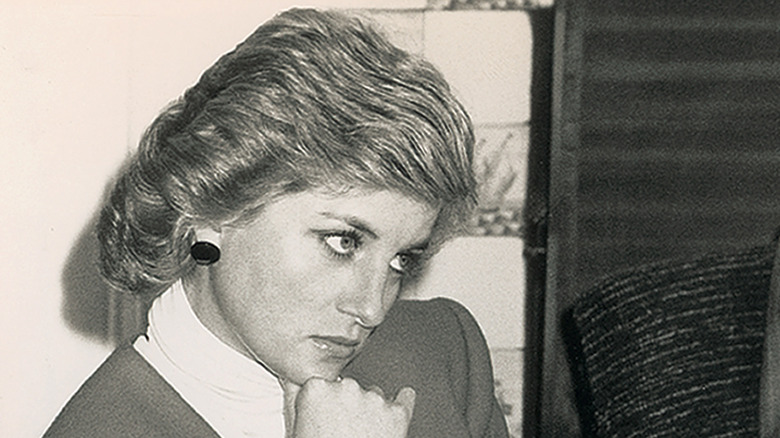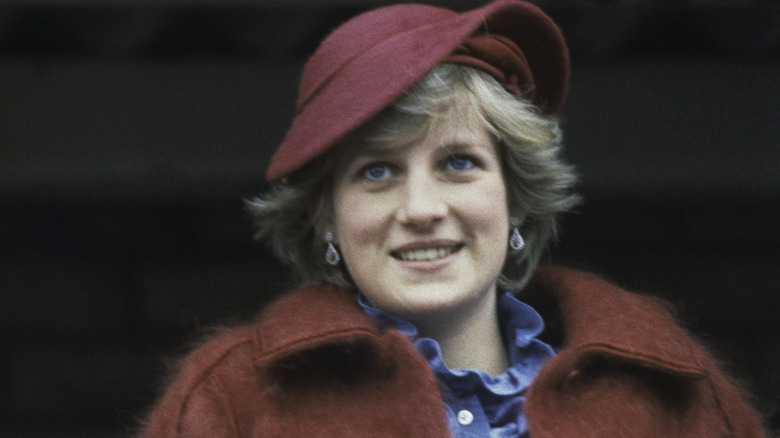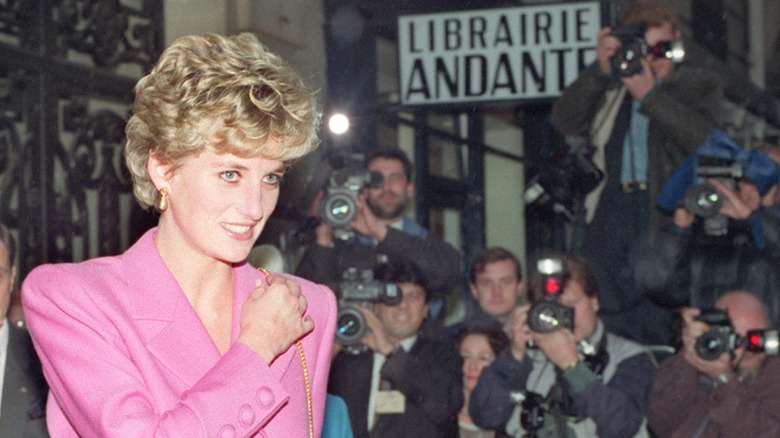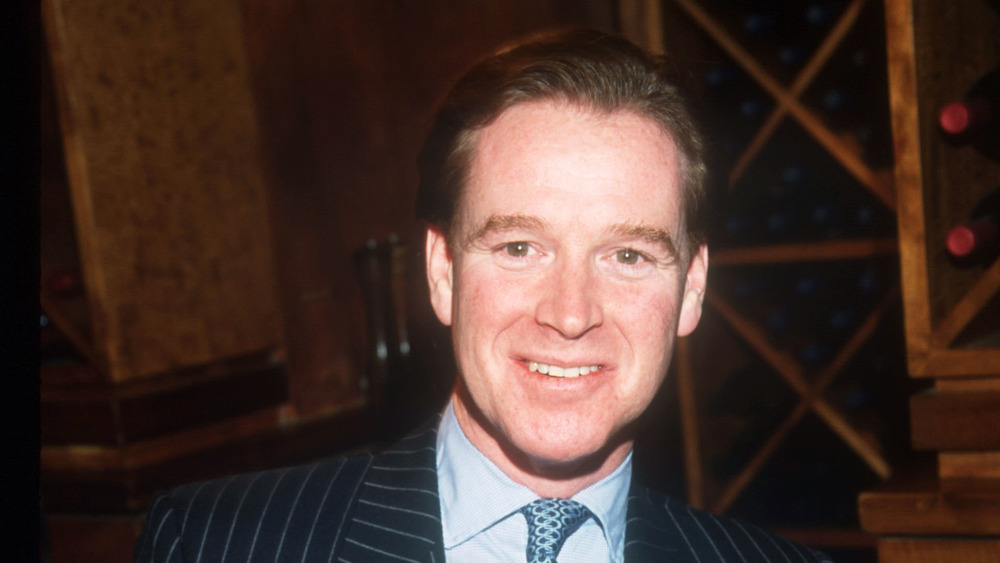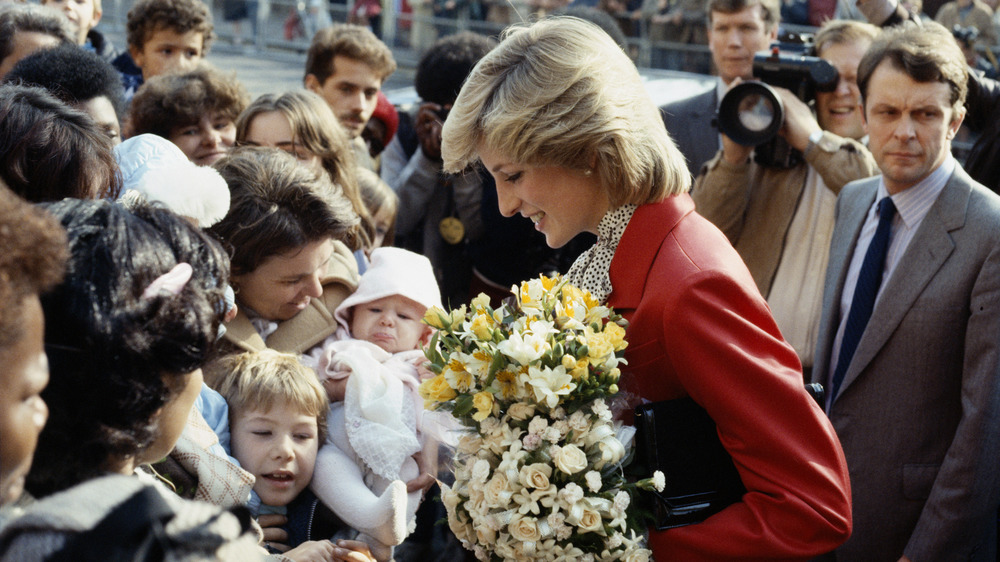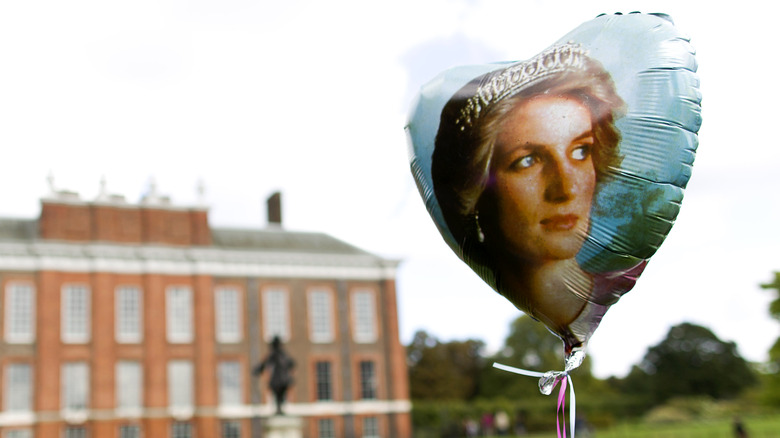The Untold Truth Of Princess Diana
The late Princess Diana was many things to many people, but her short life's legacy was solidified due, in large part, to how it ended. Questions remain about what really happened in her final moments and whether the press played a part in her death. Certain dark corners of the internet even believe the palace had something to do with it, among many other wild theories. Plainly speaking, the People's Princess was one of a kind, and it's unlikely there will ever be anybody else like her in our lifetime.
Mystery clung to Diana like the fine couture she often sported, and there are many things about her that we'll never understand. She was an intensely private person, uncomfortable with the glare of the paparazzi lens. And she deserves an element of peace, especially given her untimely passing and the two dedicated sons she left behind. Still, there are certain things we know to be true about the Princess of Wales. Let's take a look at some of the little-known facts about the incomparable Diana.
Her family was very close with the Winsdors
Even as a child, Princess Diana was no stranger to the House of Windsor royal family. Diana, born on July 1, 1961, was "the youngest daughter of the then Viscount and Viscountess Althorp, now the late Earl Spencer and the Hon Mrs Shand-Kydd," as noted by the BBC. She was born at Sandringham, which is one of the Queen's private estates, and spent much of her early childhood there as well. She also counted young princes Edward and Andrew among her childhood playmates, and even knew Queen Elizabeth as "Aunt Lilibet," according to a 1981 Daily Times article about her marriage to Prince Charles.
The same Daily Times article noted that her father had served as a royal equerry in the palace, first for King George and later for a young Queen Elizabeth, and her mother had been a lady-in-waiting for the Queen Mother. In fact, according to the BBC, when her parents married in 1954, the Queen was "the chief guest" — and the ceremony, which was held in Westminster Abbey, was considered to be "the social event of the year."
School wasn't Princess Diana's strong suit
The fact that Princess Diana didn't excel in academic settings — she reportedly failed the first stage of her General Certificate of Education exams, known as the O Levels, twice — greatly affected her self-esteem, according to biographer Tina Brown in The Diana Chronicles. "She thought she knew nothing and was very stupid," historian Paul Johnson told Brown. "She'd say things like 'I am very thick and uneducated.'"
Diana was, however, gifted in other areas, most notably when it came to her emotional intelligence. "Diana made her warmth available to anyone regardless of race, creed, or nationality," wrote Brown. "An invisible thread of kindliness drew her to people who expected the least and needed the most."
Johnson told Brown, "She had something that very few people possess. She had extraordinary intuition and could see people who were nice and [be] warm to them and sympathize with them...Very few people compare to what she had.'"
She loved to dance
In addition to her off-the-charts emotional intelligence and empathy, Princes Diana was also a talented diver and dancer. Her diving skills when she was growing up made her notorious for the "Spencer Special" — in which she'd "dive into the pool leaving barely a ripple," according to biographer Andrew Morton in Diana: Her True Story. While her swimming and diving skills were impressive, dance was where she truly found her passion.
"She loved her ballet and tap-dancing sessions and longed to be a ballet dancer," wrote Morton, but at five feet 10 ½ inches, was considered too tall for such a role. Nonetheless, she loved dancing. "As she danced she could lose herself in the movement. Often she crept out of her bed in the dead of night and sneaked into the new school hall to practice," Morton wrote, adding that Diana told him, "It always released tremendous tension in my head."
Her passion for dance continued after she became a royal. In 1985, she and Wayne Sleep, a principal dancer with the Royal Ballet, orchestrated a duet that they rehearsed in secret and then performed together in a private show for friends of the Royal Ballet. According to Sleep in an interview with The Guardian, the surprise worked out perfectly. "The audience gasped when Diana appeared, as if they'd all taken one huge breath," he said. "The routine had a bit of everything: jazz, ballet, even a kickline... She loved the freedom dancing gave her."
Princess Diana first met Charles because he was dating her older sister
While the world saw Prince Charles and Princess Diana's marriage as a fairy tale, their entire courtship, engagement, and run-up to the wedding was fraught with mixed signals, archaic traditions, and red flags that the union wouldn't turn out well.
First and foremost were the circumstances of their initial meeting: with a 12-year age difference between them, Diana first encountered Charles when she was 16 and he was 28. He had come over to the Spencer estate for a pheasant shoot — and he was also dating Diana's older sister, Sarah. He and Sarah soon ended their romance, and he began to pursue Diana, according to a 1981 The Daily Times article.
She had only met with Charles 13 times before their wedding, and his efforts to woo Diana were rife with mixed signals. "He would ring me up every day and then not contact me for weeks; he wasn't very consistent in his courtship," she said in interviews, circa 1992-1993, that were aired as part of a documentary commemorating the 20th anniversary of her death (via the Independent). Adding to which, there's the heebie-jeebies-inducing fact that "in order to satisfy the requirements of royalty, she was subjected to a discreet gynecological examination to ensure she could bear the heirs of the future King Charles III. It was felt necessary to make a public declaration of her untainted past, to announce in effect that she was a virgin," according to The Daily Times.
She had doubts about marrying Charles
Perhaps not surprisingly, Princess Diana reportedly wasn't convinced that her marriage to Charles was a good idea. Her suspicions and feelings of unease were confirmed days before the wedding, according to Diana: Her True Story. Charles planned to give Camilla Parker Bowles, his longtime mistress, a gold chain bracelet engraved with the initials "F" and "G" entwined — the initials stood for Fred and Gladys, which were believed to be their nicknames for each other — and Diana discovered the gift. After confronting him about it, he remained insistent upon giving Camilla the bracelet. At that point, Diana told her sisters about her misgivings.
"On the Monday before her wedding day, Diana gave serious consideration to calling to a halt the whole affair. At lunchtime she knew that Prince Charles had gone to present Camilla with her gift.... At the time he was seeing Camilla, Diana had lunch with her sisters and discussed her predicament with them. She was confused, upset, and bewildered by the train of events...they made light of her fears and premonitions of the disaster which lay ahead. 'Bad luck, Duch,' they said, using the family nickname for their younger sister, 'your face is on the tea-towels so you're too late to chicken out.'"
(And with that, dear reader, a brief public service announcement: listen to your instincts. If you're uncomfortable with a person or set of circumstances, please know that those feelings are valid. Also, please don't marry anyone who hurts your feelings!)
One of Princess Diana's greatest loves was a Pakistani surgeon
While Dodi Fayed, who was killed along with Diana in the famous Paris car accident, is perhaps the most well-known of her boyfriends, it's believed that Diana's greatest love was Hasnat Khan, a Pakistani heart surgeon she met in 1995. Khan was the surgeon for Joseph Toffolo, the husband of Diana's acupuncturist Oonagh, who was recovering from a triple bypass. Toffolo suffered complications and had to be rushed back into the operating room. Khan first encountered Diana when he went to inform Oonagh of Toffolo's imminent surgery. Khan and Diana went on to have a two-year relationship that was described as Diana's "most significant relationship since her marriage to Prince Charles," according to Vanity Fair.
Khan broke the mold of Diana's typical love interest: he was reportedly serious, down-to-earth, committed to his work as a surgeon, and utterly normal. "Diana threw herself into the almost aggressive normalcy of his existence," notes Vanity Fair. "Her friends tell stories about how she puttered around his small one-bedroom apartment and tidied up, doing the dishes and folding his laundry. Hasnat didn't ride or hunt. He liked jazz and Guinness, so he and Diana stood in line to see the late-night acts."
The relationship ended during the summer of 1997, and according to Vanity Fair, many suspect that Diana's fling with Fayed was engineered to make Khan jealous. Khan has largely stayed silent on his relationship with Diana.
She spoke out about mental health
Diana was willing to speak openly and candidly about her mental health challenges, which was virtually unheard of at the time — especially in aristocratic and royal circles. By being honest about her private battles with bulimia, depression, and anxiety, Diana "inspired honesty in others through her compassion and willingness to communicate her own experiences," according to Healthline, speaking about what Diana said at Turning Point's June 1993 conference.
According to Healthline, Princess Diana asked, "Isn't it normal not to be able to cope all the time? Isn't it normal for women as well as men to feel frustrated with life? Isn't it normal to feel angry and want to change a situation that is hurting? Perhaps we need to look more closely at the cause of the illness rather than attempt to suppress it. To accept that putting a lid on powerful feelings and emotions cannot be the healthy option."
Diana's candor and openness were "groundbreaking," as Vogue noted. "Simply put, no one talked about this kind of stuff in the '90s. They barely talk about it now. The fact that the Princess of Wales opened up about her mental health problems was game changing." As a result, more people have become willing to discuss their own experiences with mental health challenges, such as depression, anxiety, eating disorders, and feelings of inadequacy.
She communicated through fashion
Fashion and style were among Princess Diana's favorite means of communication and self-expression, and she found them deeply cathartic. For example, in the early stages of her relationship with Charles, she was photographed wearing two watches during Charles' polo matches. One watch was hers, the other belonged to Charles, and according to Marie Claire UK, "She wore it as a tribute to him, and to wish him luck in the match."
Using fashion and style as a means of communication was a habit continued throughout Diana's life. As Eleri Lynn, curator of "Diana: Her Fashion Story," an exhibition at Kensington Palace, told Vanity Fair, "It is very surprising how little footage there exists of the Princess actually speaking. We all have a sense of what we think she was like, and yet so much of it comes from still photographs, and a large part of that [idea] is communicated through the different clothes that she wore."
Her fashion sense also evolved considerably over the years: she went from favoring frilly, romantic styles to preferring sleek, elegant silhouettes as she spent more time in the limelight. "She did clearly have fun with fashion," Lynn told Vanity Fair, "and she took risks...and experimented with her style. She was the first member of the royal family to be photographed wearing trousers to evening events. But she often teamed that with tuxedo jackets and bowties — that's quite the bold, fun look that you don't necessarily expect of a princess."
Princess Diana's charity work was groundbreaking
By working with AIDS patients at a time when the disease was seen as taboo and a source of enormous shame and fear, Princess Diana helped shatter the stigma around people stricken by the disease. She became a patron of the UK's National AIDS Trust, and in 1987 when the public panic about AIDS was at its peak — and the stigma attached to, and shame associated with, the disease left many patients isolated from friends and loved ones — she helped open the UK's first HIV/AIDS unit at the London Middlesex Hospital, according to the BBC.
Perhaps the most groundbreaking act of her advocacy came when she shook hands with an AIDS patient, and did so without wearing gloves. This came at a time when people were scared that the virus could be transmitted from person to person by shaking hands. "Diana believed that not to be true," wrote National Geographic. "The people who loved her at that time loved her even more because here was a very public figure willing to show the world that these individuals need attention and care too." Even though some people felt that this was inappropriate behavior for a royal, she never wavered in her commitment to treating AIDS patients like human beings worthy of dignity and respect.
Princess Diana admitted to being in love with someone else
Princess Diana's marriage to Prince Charles was undoubtedly dysfunctional, but there was at least one romance that went somewhat right for her. In Princess in Love, author Anna Pasternak detailed how Diana had an alleged dalliance with Major James Hewitt. O, the Oprah Magazine reported that Pasternak was told directly by Hewitt himself that the affair took place between 1986 and 1991. He wrote about it extensively in his own controversial tome, Love and War, released in 1999. According to Hewitt, the princess approached him for horse-riding lessons and they quickly fell in love.
Pasternak revealed to the Daily Mail that Hewitt would regularly sneak into Kensington Palace and was relieved to learn Charles and Diana were sleeping in separate rooms. Reportedly Charles was glad of the affair because it kept Diana busy and took the attention away from him and Camilla Parker Bowles. The secret couple are said to have regularly written love letters to each other, particularly while Hewitt was overseas, according to O, the Oprah Magazine. Their relationship ultimately ended because Hewitt was getting too serious. During her infamous BBC interview (via Time), Diana actually acknowledged the affair, admitting, "Yes, I was in love with him."
Princess Diana's explosive BBC interview is still causing shockwaves
In 1995, Princess Diana sat down with the BBC's Martin Bashir for an interview. It remains one of the most shocking and noteworthy moments of her life. As E! News noted, it's where the infamous "there were three of us in this marriage" line came from, as well as accusations of intense press scrutiny that led to Diana being paranoid and afraid for her life. She also revealed how unhappy her then-husband was with all the coverage she got, explaining, "With the media attention came a lot of jealousy. A great deal of complicated situations arose because of that."
Diana also discussed her issues with self harm, eating disorders, and postpartum depression. Although the interview was a watershed moment, its veracity is now being called into question. As BBC News reported, an internal investigation was launched in November 2020, following accusations from the late princess' brother that Bashir forged bank statements to coerce her into a tell-all. Prince William welcomed the move, with Kensington Palace confirming in a statement reviewed by E! News, it was "a step in the right direction" that he hoped would "establish the truth."
How Princess Diana's divorce affected her
Princess Diana's divorce from Prince Charles shook her to her very core, and it actually affected her style choices in a surprising way, too. Speaking to Harper's Bazaar Australia, designer Jayson Brundson recounted meeting Diana while styling her for an event back in 1996. After choosing a Versace skirt suit, the Princess of Wales needed help with accessories but, when Brundson suggested a pair of Chanel shoes, "she said 'no, I can't wear linked Cs, the double C,'" noting, "It's Camilla and Charles."
Although she was clearly unhappy with Charles, according to royal biographer Tina Brown, author of The Diana Chronicles, Diana would've happily rekindled their romance. Brown told The Telegraph, "At the end of Diana's life, she and Charles were on the best terms they'd been for a very long time. Charles got into the habit of dropping in on her at Kensington Palace and they would have tea and a sort of rueful exchange." Diana even accepted that Charles was with Camilla. However, Brown noted, "She said to me ... that she would go back to Charles in a heartbeat if he wanted her."
Queen of people's hearts
As The New York Times noted in her obituary, Princess Diana had seemingly come into her own in the year before her death. "After recent years of loneliness, wounded vulnerability and feelings of rejection, Lady Diana struck friends this year as having acquired long-sought self-regard and hope for the future...In May Lord Attenborough, the actor and director, said: 'Once she was a shy young woman who was suddenly thrown into a bear pit. Now you see her confidence, self-assurance and outgoing nature.”'
The New York Times went on to remark that, in a 1995 interview, she said she wanted to "transform herself into the 'queen of people's hearts'...that seemed to be the thrust of her last year as she focused in on the charities she cared most about — organizations addressing AIDS, leprosy, homelessness, cancer research and the treatment of sick children, along with the English National Ballet."
While Diana's death will always be a loss, it's clear that those close to her, most notably Princes William and Harry, have worked hard to ensure that it's not also a waste. William and Harry have carried on her humanitarian work by championing the causes she loved, such as land mine eradication, AIDS advocacy, and the de-stigmatization of mental health care. Indeed, her memory lives on in the minds of millions — and, perhaps most importantly, in their hearts as well.
